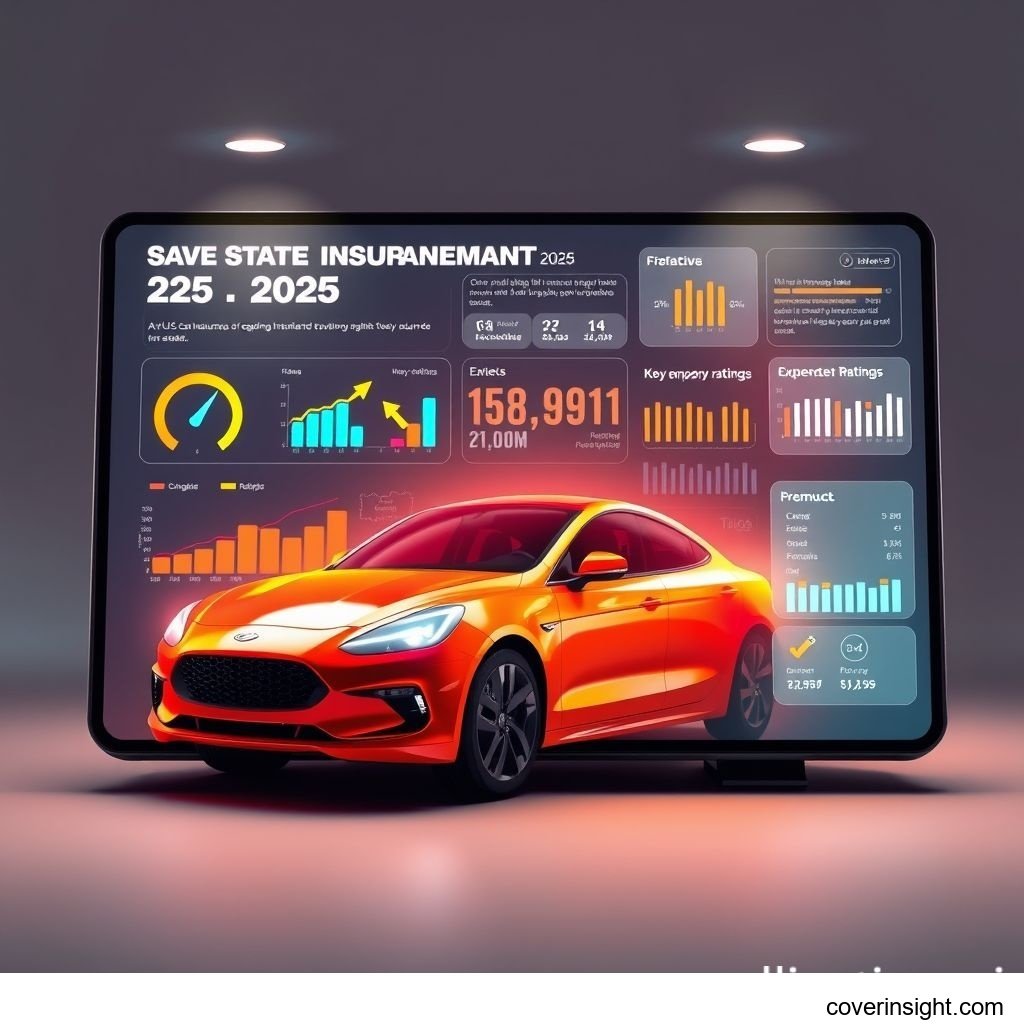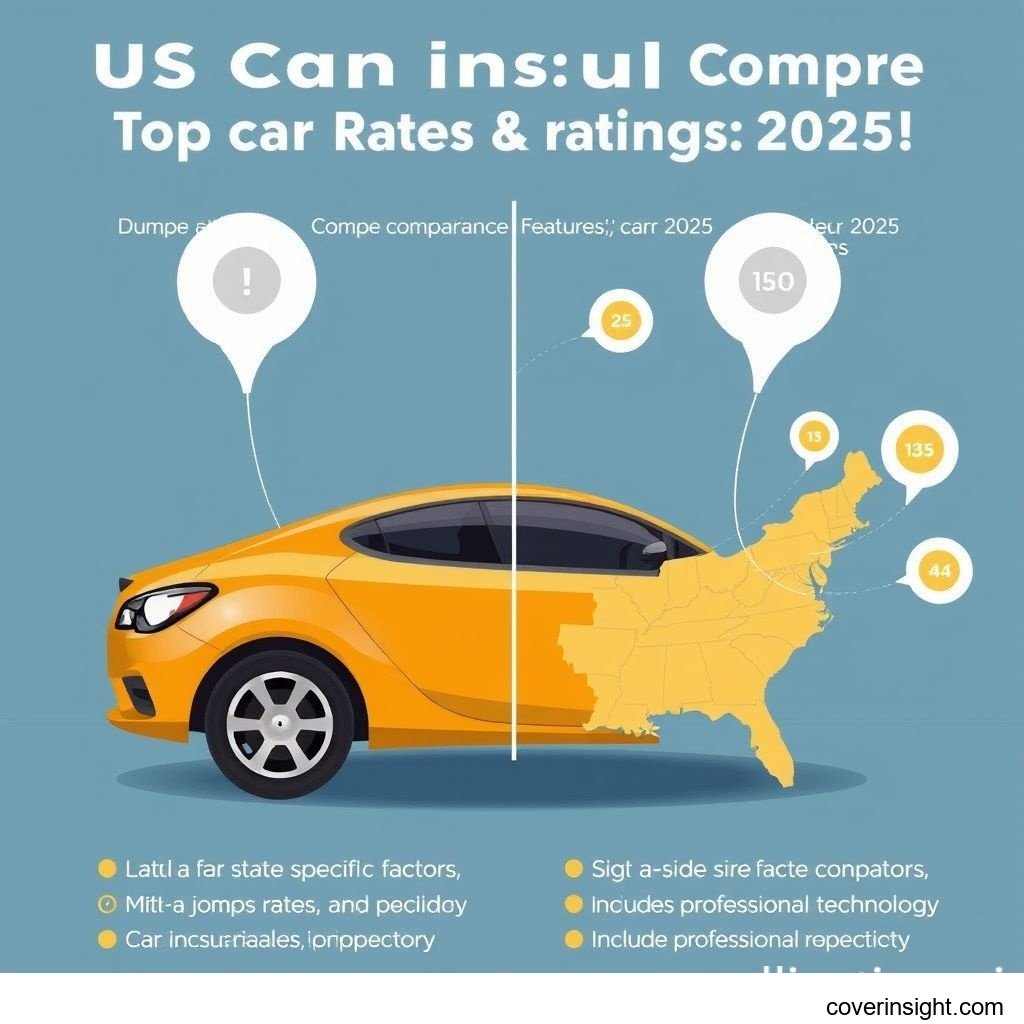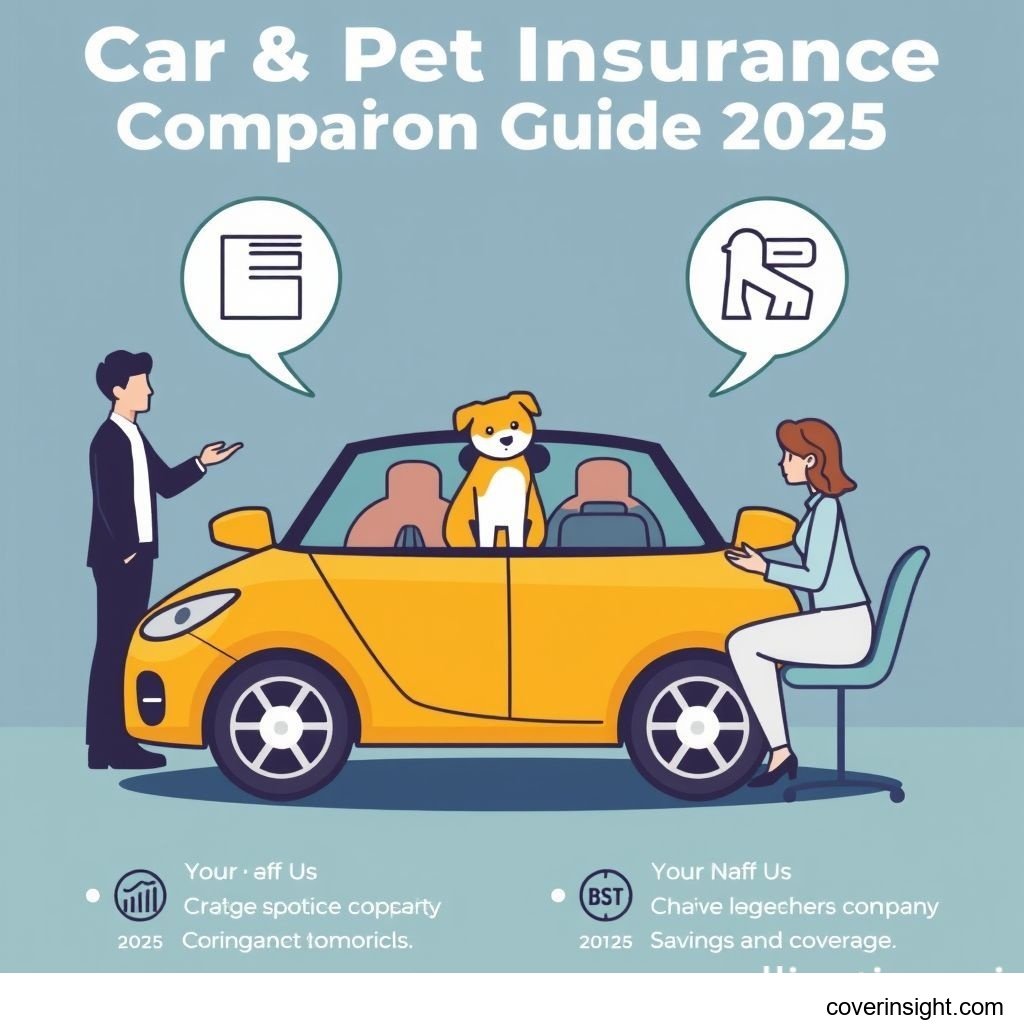Introduction
Navigating the complex landscape of car insurance in the US for 2025 requires smart strategies. As vehicle technology advances and economic factors shift, understanding your options becomes paramount. This comprehensive guide helps you master car insurance comparisons, ensuring you find the right coverage at the best possible price. Effective comparison is not just about saving money; it is about securing peace of mind on the road.
The importance of thorough car insurance comparisons cannot be overstated. It protects you financially against unexpected accidents, theft, or natural disasters. With numerous providers and policy variations available, making informed decisions is crucial for every driver seeking optimal protection and value.
Coverage Details
Understanding the different types of coverage is the first step in effective car insurance comparisons. Policies are not one-size-fits-all, and selecting the right components ensures you are adequately protected without overpaying.
What’s Included
Most standard car insurance policies in the US include several key components designed to protect you in various scenarios.
Key coverage types often found in a policy:
-
Liability Coverage: Mandatory in most states, this covers damages and injuries you cause to others in an at-fault accident.
-
Bodily Injury Liability: Pays for medical expenses and lost wages for injured parties.
-
Property Damage Liability: Covers repair or replacement of property you damage.
-
-
Collision Coverage: Pays for damage to your own vehicle resulting from a collision with another vehicle or object, regardless of fault. This is typically optional but highly recommended for newer cars.
-
Comprehensive Coverage: Protects your car from non-collision incidents such as theft, vandalism, fire, falling objects, or natural disasters. This is also optional but provides broad protection.
-
Uninsured/Underinsured Motorist (UM/UIM) Coverage: Covers your medical expenses and vehicle damage if you are hit by a driver who has no insurance or insufficient insurance.
-
Personal Injury Protection (PIP) / Medical Payments (MedPay): Covers medical expenses for you and your passengers, regardless of who is at fault. PIP may also cover lost wages and essential services.
These core coverages form the backbone of most policies. Knowing what each offers simplifies the process of car insurance comparisons.
Common Exclusions
While policies offer extensive protection, it’s equally important to understand what is typically not covered. Awareness of these exclusions helps avoid surprises and ensures you seek appropriate supplemental policies if needed.
Typical exclusions often include:
-
Intentional Damage: Damage caused by intentional acts.
-
Using Your Car for Business (Without Proper Endorsement): Standard personal policies usually don't cover commercial use.
-
Wear and Tear: Routine maintenance or damage from normal use.
-
Racing or Stunt Driving: Any damage incurred during illegal activities or competitive events.
-
Damage from War or Nuclear Events: Catastrophic events beyond typical scope.
-
Aftermarket Parts Not Declared: Customizations or enhancements not reported to the insurer.
-
Driving Under the Influence (DUI/DWI): While liability might pay for third-party damages, your own vehicle damage may not be covered.
Always review your specific policy documents carefully to understand all terms and conditions.
Cost Analysis
The cost of car insurance varies significantly based on numerous factors. Performing effective car insurance comparisons requires a clear understanding of what influences premiums.
Price Factors
Insurers assess a wide range of variables to determine your premium. These factors reflect your risk profile and the likelihood of you filing a claim.
Key elements influencing your car insurance premium:
-
Driving Record: A clean record with no accidents or violations generally leads to lower rates. Speeding tickets or DUIs significantly increase costs.
-
Vehicle Type: Sports cars, luxury vehicles, or those with high theft rates typically cost more to insure due to higher repair costs or theft risk.
-
Location: Urban areas with higher traffic density, theft rates, or vandalism incidents often have higher premiums than rural areas.
-
Age and Gender: Younger, less experienced drivers (especially males) often face higher rates. Rates tend to decrease with age and experience.
-
Credit Score: In many states, a higher credit score is associated with lower insurance risk, leading to better rates.
-
Annual Mileage: Driving fewer miles generally reduces your risk of an accident, potentially lowering premiums.
-
Coverage Limits and Deductibles: Choosing higher liability limits and lower deductibles will increase your premium, as the insurer takes on more risk. Conversely, higher deductibles lower your premium.
(Image alt text: A graph showing various factors affecting car insurance comparisons costs.)
Saving Tips
Reducing your car insurance costs doesn't mean sacrificing essential coverage. Smart strategies can significantly lower your premiums, making your car insurance comparisons more fruitful.
Practical ways to save on car insurance:
-
Bundle Policies: Combine car insurance with home or renters insurance from the same provider for multi-policy discounts.
-
Increase Deductibles: Opting for a higher deductible reduces your premium, but ensure you can afford the out-of-pocket expense if you file a claim.
-
Take a Defensive Driving Course: Many insurers offer discounts for completing approved defensive driving programs.
-
Maintain a Good Driving Record: Avoid accidents and traffic violations to keep your rates low.
-
Improve Your Credit Score: A better credit score can lead to lower premiums in many states.
-
Inquire About Discounts: Ask your insurer about available discounts for things like good student status, low mileage, anti-theft devices, or loyalty.
-
Drive a Safer Vehicle: Cars with high safety ratings and advanced safety features may qualify for discounts.
-
Consider Usage-Based Insurance: Programs that monitor your driving habits can offer savings for safe drivers.
Regularly review your policy and get new quotes to ensure you're always getting the best deal.
Navigating the Market: Insurance Broker vs Direct
When embarking on car insurance comparisons, you'll encounter two primary avenues for purchasing policies: directly from an insurer or through an independent broker. Both have distinct advantages and disadvantages.
Pros and Cons of Each
Understanding the differences between buying direct and using a broker can significantly impact your experience and the outcome of your car insurance comparisons.
Direct Purchase (from an insurance company):
-
Pros:
-
Direct Communication: You deal directly with the insurer, potentially streamlining communication for claims or policy changes.
-
Brand Specific Discounts: Access to discounts specific to that particular company.
-
Online Convenience: Many direct insurers offer robust online portals for quotes, policy management, and claims submission.
-
-
Cons:
-
Limited Options: You only receive quotes from that one company.
-
Self-Service Required: You are responsible for comparing quotes from multiple companies yourself.
-
Insurance Broker:
-
Pros:
-
Multiple Quotes: Brokers work with several insurance companies, providing you with a range of quotes and options from different carriers. This can significantly simplify car insurance comparisons.
-
Expert Advice: Brokers offer personalized advice, helping you understand complex policy terms and choose appropriate coverage.
-
Advocacy: They can act as an advocate on your behalf during claims or disputes.
-
Time-Saving: They do the comparison shopping for you, saving you considerable time and effort.
-
-
Cons:
-
Commission-Based: Brokers earn commission from the insurers, which might slightly influence their recommendations (though reputable brokers prioritize client needs).
-
Less Direct Control: Communication might go through the broker rather than directly with the insurer.
-
Making the Right Choice
The best approach often depends on your comfort level with research and your need for personalized guidance. If you enjoy doing your own research and feel confident navigating policy details, buying direct from a few top carriers might work. However, for most consumers, particularly those with unique circumstances or limited time, a broker offers invaluable assistance in car insurance comparisons.
To ensure you make an informed decision, consider these points:
-
Your familiarity with insurance terminology and policy structures.
-
How much time you can dedicate to researching and comparing quotes.
-
Your specific coverage needs and whether they are straightforward or complex.
-
The value you place on personalized advice versus a self-service approach.
Special Considerations: High-Risk Pool Options
Certain drivers are classified as "high-risk" by insurance companies, often due to a history of accidents, serious traffic violations, or a lack of driving experience. This classification can make car insurance comparisons more challenging, leading to higher premiums or even difficulty finding coverage.
Understanding High-Risk Classifications
Insurers categorize drivers based on statistical risk. Several factors can place a driver into a high-risk category:
-
Multiple Accidents: A history of at-fault collisions.
-
Serious Traffic Violations: DUIs/DWIs, reckless driving, or numerous speeding tickets.
-
Young or Inexperienced Drivers: Especially those under 25, without a long driving history.
-
Lapse in Coverage: A period where you did not have active insurance coverage.
-
Specific Vehicle Types: Certain high-performance or modified vehicles.
-
Poor Credit Score: In states where credit is a rating factor, a low score can increase perceived risk.
Being labeled high-risk doesn't mean you can't get insurance, but it does mean your options may be more limited and costly.
Finding Coverage in High-Risk Pool Options
For high-risk drivers, traditional car insurance comparisons might yield few results. This is where specialized options come into play.
Ways to find coverage for high-risk drivers:
-
Non-Standard Insurers: Some insurance companies specialize in insuring high-risk drivers. These insurers might have higher premiums but are more willing to offer coverage.
-
State-Mandated High-Risk Pools (Assigned Risk Plans): In many states, if you are unable to obtain coverage from the voluntary market, you can apply through an "assigned risk plan."
-
These plans ensure that every licensed driver can obtain the minimum required liability insurance.
-
Insurers in the state are required to take a share of these high-risk drivers.
-
Premiums in these pools are typically higher than standard rates but provide a vital safety net.
-
-
SR-22 or FR-44 Filings: If your high-risk status is due to a DUI or severe violation, you may be required to get an SR-22 or FR-44 filing. This is not insurance itself, but a certificate of financial responsibility that your insurer files with the state, proving you have coverage. Many non-standard insurers are familiar with these requirements.
(Image alt text: A diagram showing pathways for high-risk drivers to obtain car insurance comparisons.)
Working with an independent insurance broker can be particularly beneficial for high-risk drivers, as they often have access to a wider range of non-standard carriers and can help navigate the complexities of state-assigned risk plans.
How to Perform Effective Car Insurance Comparisons
To truly "save smart," you need a methodical approach to comparing policies. This isn't just about price; it's about finding the right balance of coverage, cost, and customer service.
Step-by-Step Comparison
Follow these steps for a thorough and effective car insurance comparisons process:
-
Gather Your Information:
-
Driver details (DOB, driving history, address).
-
Vehicle details (VIN, make, model, year, safety features).
-
Current policy details (if applicable).
-
Desired coverage limits and deductibles.
-
-
Determine Your Needs:
-
What are your state's minimum liability requirements?
-
Do you need comprehensive and collision coverage for your vehicle?
-
Consider additional coverages like roadside assistance or rental car reimbursement.
-
-
Get Multiple Quotes:
-
Use online comparison tools.
-
Contact individual insurance companies directly.
-
Consult with an independent insurance broker. Aim for at least 3-5 quotes.
-
-
Compare Apples to Apples:
-
Ensure each quote offers identical coverage limits, deductibles, and endorsements. Small differences can lead to vastly different prices.
-
Look beyond the premium: consider the insurer's financial strength ratings (e.g., A.M. Best), customer service reviews, and claims handling reputation.
-
-
Inquire About Discounts:
-
Before finalizing, ask each insurer about all available discounts you might qualify for.
-
Examples: multi-policy, good student, safe driver, telematics programs, anti-theft devices.
-
-
Review Policy Details Thoroughly:
-
Read the fine print. Understand exclusions, limitations, and terms.
-
Ensure the payment structure (monthly, quarterly, annually) fits your budget.
-
-
Make Your Decision:
- Choose the policy that offers the best blend of coverage, price, and reliable customer service.
Essential Tools for Car Insurance Comparisons
Several resources can make your comparison journey easier and more effective.
Valuable tools and resources include:
-
Online Comparison Websites: Sites like Policygenius, Insurify, and The Zebra allow you to input your information once and receive multiple quotes.
-
Individual Insurer Websites: Major insurers like Progressive, Geico, State Farm, and Allstate offer direct online quoting tools.
-
Independent Insurance Brokerage Services: These professionals leverage their networks to get you quotes from various carriers, simplifying complex car insurance comparisons.
-
State Insurance Department Websites: Your state's Department of Insurance can provide consumer guides, complaint ratios, and sometimes even rate comparison tools. Find your state's department via the National Association of Insurance Commissioners.
-
Consumer Reviews and Ratings: Websites like J.D. Power, Consumer Reports, and A.M. Best provide insights into customer satisfaction, financial stability, and claims handling.
(Internal link: For broader insights into global insurance trends, visit Insurance Resources Global.)
By utilizing these tools, you can confidently navigate the market and find the ideal policy. Don't forget that your personal car insurance comparisons journey should lead to both savings and peace of mind.
FAQs
Here are some frequently asked questions about car insurance comparisons in the US for 2025.
How much does car insurance comparisons cost?
The "cost" of car insurance comparisons itself is free; it refers to the process of obtaining and evaluating quotes. The actual cost of car insurance, or your premium, varies widely. It can range from a few hundred dollars to several thousand dollars annually, depending on numerous factors like your driving record, vehicle type, location, and the coverage you choose.
What affects premiums?
Premiums are influenced by a combination of personal, vehicle, and geographic factors. Your driving history (accidents, violations), credit score (in most states), age, gender, the type of car you drive, where you live, and the coverage limits and deductibles you select all play a significant role. Insurers assess these factors to determine your individual risk profile.
Is it mandatory?
Yes, car insurance is mandatory in almost every US state. Nearly all states require drivers to carry a minimum amount of liability insurance to cover damages or injuries you might cause to others in an accident. New Hampshire is a notable exception, though even there, financial responsibility is required. Failure to comply can result in fines, license suspension, or even vehicle impoundment. For more general US insurance information, you can visit US Insurance Home.
How to choose?
Choosing the right car insurance involves balancing cost with adequate coverage. Start by assessing your needs, considering your vehicle's value and your financial risk tolerance. Gather multiple quotes using car insurance comparisons tools or a broker. Compare policies side-by-side, focusing on coverage types, limits, deductibles, and potential discounts. Also, research the insurer's reputation for customer service and claims handling through sources like the National Association of Insurance Commissioners.
Consequences of no coverage?
Driving without mandatory car insurance carries severe consequences. These can include:
-
Fines: Significant monetary penalties.
-
License Suspension: Your driver's license can be suspended or revoked.
-
Vehicle Impoundment: Your car might be seized by authorities.
-
SR-22/FR-44 Requirements: You may be required to file proof of future financial responsibility, leading to higher insurance costs for years.
-
Financial Liability: If you cause an accident, you will be personally responsible for all damages and medical expenses out of pocket, which can be devastating.
Always ensure you have at least the minimum required coverage to avoid these penalties and protect your financial well-being.








Comments